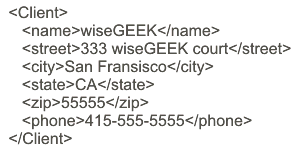XML (eXtensible Markup Language) is a less complex, more concise dialect of the larger more complex SGML (Standard Generalized Markup Language). In the simplest terms, this language uses syntax tags to identify various types of data in a file. For example:

XML makes it very easy for various programs to extract data because the tags conform to particular models. Above we see a data model with 7 elements:
Client (parent element), contains 6 nested elements: name, street, city, state, zip and phone.
Name: XML-aware programs know this field holds the name of a person or company.
Street: This field will hold a street address.
City: Here it will find the city.
State: The abbreviated 2-letter state code.
Zip: The 5-digit zip code.
Phone: The phone number.
To define the data model or content of each of the elements a DTD (Document Type Definition) can be used. A DTD is one way to define the structure or tree of an XML document. A DCD (Document Content Description), DDML (Document Definition Markup Language), SAX (Simple API for XML), and XSCHEMA are others.
Although the simplified example above only hints at the very basics of this language, it should already be clear how it differs from HyperText Markup Language (HTML). The tags used in HTML dictate how material should be presented on a webpage, without indication as to what the material is. Manipulation or reuse of data inside a HTML file for further purposes is not viable. However, data contained in a webpage written in XML can be manipulated, extracted by various database systems and recycled.
When using HTML to create webpages style sheets are often used. Known formally as Cascading Style Sheets, a CSS adds style elements to a HTML webpage.
Webpages can also be written in XML. In this case the equivalent of the CSS is the XSL (eXtensible Stylesheet Language), implemented the same way.
The XSL actually serves two functions. It contains instructions to XML-aware browsers how to render the code for graphic purposes, but it also contains instructions for transforming the data into other formats, referred to as XLST. XSLT can generate a file different in structure from the original. This is especially useful in areas like e-commerce, for example, where customer input like name, credit card number, dollar amount, etcetera is pushed through a series of system programs in the processing of payment. The transforming function of XSLT is unhindered by rendering needs, and solely concerned with moving data successfully between networks and programs for processing purposes. In an age where exchange of information is in such high demand XML is an obvious choice over HTML.
XML, created by the World Wide Web Consortium (W3C), is part of a large family of markup languages and is defined as a metalanguage — a language that describes other languages. One of the goals of W3C was to make XML "optionless" so that it would remain pure, unlike HTML which has many different conventions and as a result is rendered differently on various browsers, making it difficult to present data in a uniform fashion.
As of the March 2005 tests, released by the W3C revealed Microsoft Internet Explorer 6.0 SP2 had limited XML ability, reportedly using it own flavor of the language that may not always comply with the standards set forth. Netscape had good compatibility with a few problems in the 8.0 beta version, while Firefox and Mozilla had the best results of free browsers, with fully implemented, 100% compatible XML rendering ability in all of their available browser versions to date.
Because XML-pages provide so much more flexibility than HTML pages, it is expected to replace HTML as the language of choice. For more information, you can visit the official W3C site. Online tutorials and many books are also available. Learning the language may require a ramp-up but experts predict the investment is well worth the time.








